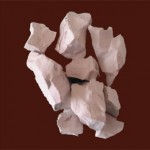How Found Bentonite
Bentonite is a natural inert clay that was formed from volcanic activity during the Cretaceous period approximately 100 million years ago. Long periods of repeated eruptions laid ash into the sea where it was chemically altered and consolidated into layers of clay. Over time the ground folded and lifted thrusting up the clay and silt to form the Black Hills and Big Horn mountains of Wyoming, USA. The term bentonite is generally applied to colloidal clay associated with the Cretaceous Benton shale found near Fort Benton. Bentonite mining first began in 1888.
The first recorded use of the mineral known as “the clay of a thousand uses” was for making cosmetics, it then became used as a foundry sand bond in the 1920s followed soon after as a drilling mud. The uses have continued to expand into the fields of bleaching clay, animal feeds, pharmaceuticals, colloidal fillers for paints and inks, ceramics and in the motor industry for spark plugs and catalytic converters.
Bentonite was formed all over the world during the Cretaceous periods, these bentonites are categorised into sodium and calcium bentonites (calcium varieties are commonly found in many areas of all continents). When bentonite comes into contact with water, the atoms and molecules dissolve and ions with negative charges develop. These negative charges cause a mutual repulsion and thus a swelling. Calcium bentonites are known as low swelling bentonite due to their swell capacity of only 3 times their own dry volume.
These minerals are divalent in their formulation and as such they are stable. In sodium based bentonites the clay absorbs nearly 5 times its weight of water. At full saturation it can therefore swell to 16 times its own dry volume. The sodium bentonites are monovalent and as such unstable.
Sodium Bentonite consists of at least 90% montmorillonite and 10% other minerals, the most abundant being feldspar, quartz, calcite and gypsum. The montmorillonite is a three sheet structure mineral formed of several layers of tetrahedron and octahedron sheets, these sheet are parallel orientated, on the surface of the sheets there are atoms and molecules. When the sodium bentonite swells the charges cause the bentonite platelets to bond together and form a seal that acts as a very high quality waterproof barrier. The swelling occurs as the water enters the platelets, if the water contains “impurities” these are taken into the inter layers between the platelets where they can create a change in the formulation of the clay causing it to convert or exchange.
This cation exchange causes the high swelling unstable sodium bentonite to convert to a low swelling stable calcium bentonite. The effect this has is to cause the bonds between the clay particles to break as the clay shrinks back when it exchanges causing fissures or cracks to appear in the surface of the clay, these cracks allow the passage of water through clay and causing the barrier to leak.




